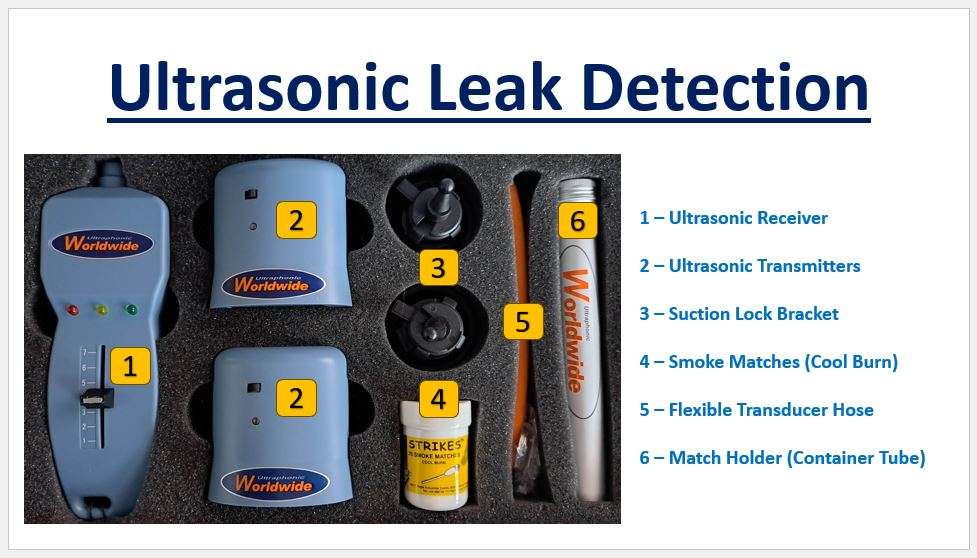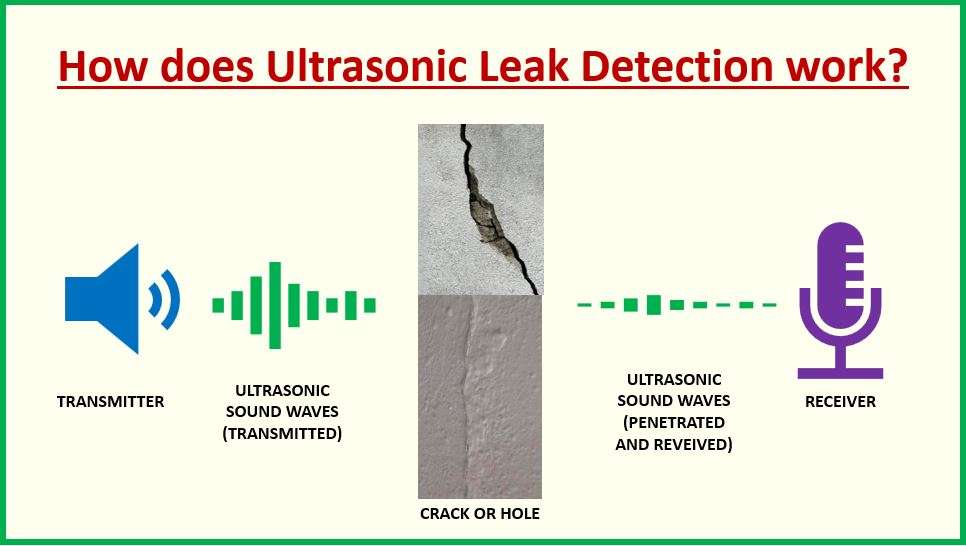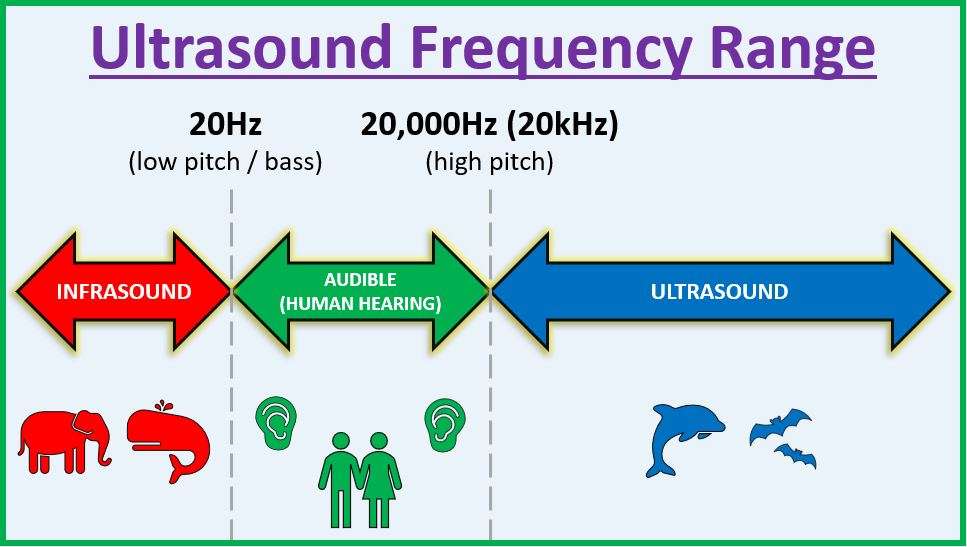Before we explain it, here is a quick demonstration of an ultrasonic leak detection kit working:
We’ve previously explained some of the most common ways we deliver a our local leak detection service, but in this handy guide, we are going to discuss something that is more specialist. Namely ultrasonic leak detection to locate water leaks in homes and businesses.
As you can see, when the air-tight container is locked closed the light is green and no ultrasonic sound is being detected, however, once one of the clips are opened and the seal is ‘broken’ it is no longer air-tight and the sound can travel through the gap. The light turns red to signify this.

Ultrasonic leak detection can be a handy leak detector to have in your arsenal but it does have some limitations which we will explain further in this article. After this short read, you will understand how ultrasonic water leak detection works better.

As you can see from the image above, we are going to use the Ultraphonic Worldwide UW333 Ultrasonic Leak Detection Kit as a good example of the components in a typical kit. Other manufacturers produce ultrasonic leak detection for the UK market to, with some for very specific uses, and they work on similar principles.
The components contained in this particular ultrasonic leak detection kit include:
- The Ultrasonic Receiver
- Two Ultrasonic Transmitters
- Suction Lock Brackets (like used for satnavs)
- Smoke Matches (cool burn)
- A Flexible Transducer Hose
- A Match Holder (within a tube container)
What is Ultrasonic Leak Detection?
Like acoustic leak detection, ultrasonic leak detection uses sound to help locate water leaks. Like many of the other water leak detection methods we have discussed previously, it works best in conjunction with other methods to help maximise the evidence needed to pinpoint a water leak in a property.
However, it works in a very different way. With acoustic water leak detection, you are typically listening for the sound of the actual water leak, drip or spray. In contrast, ultrasonic leak detection is helping to locate holes, gaps or cracks through which water may be able to pass through. For example, a roof leak, ceiling leak etc.

Even though we are going to look at how ultrasonic leak detection works for water leaks, it does have a number of other applications in other industries. Ultrasonic leak detection can be used for air / gas leaks, HVAC leaks, leaks in cars (including in things like window and door seals) and leaks in ducting etc.
So the next obvious question is…
How does Ultrasonic Leak Detection work?
To help explain how it works, we will use some simple analogies for comparison before going into the more technical detail. Imagine you were trying to talk to someone directly through a solid brick wall, it is very unlikely they would be able to hear the audible words you are speaking as the sound waves cannot pass through it.
Now imagine you drilled some holes through the wall, then the sound would be able to pass through and they would hear you. Ultrasonic leak detection works on a similar method, but looking for small gaps, cracks and holes that water may ingress through, helping to trace and access leaks.
This diagram helps to explain it further:

So as you can see, on the left we have the transmitter sending out ultrasonic sound waves which are inaudible to the human ear (we will explain them in a moment!). On the other side of the barrier, which could be a wall, floor or ceiling is a receiver which is listening out for the tell-tall ultrasonic sounds being transmitted.
If it hears them, it provides an alert on the device (with red, amber and green lights), showing that there is more likely to be some route for them to pass through. Note – ultrasonic sound is very short wavelength making it better for getting through small gaps.

As you can see above, humans can typically hear sounds in the audible hearing range between 20Hz and 20,000Hz (20kHz / 20 Kilohertz). Below that range the sounds are lower pitch, low-frequency sound waves known as Infrasound and above that range is high-frequency / high pitch sounds known as Ultrasound!
So when the ultrasonic leak device is being used, you will not hear a sound.
You can see on the image below how some animals use ultrasound (and infrasound) for communication and additionally echo-locations like bats and dolphins use to precicely locate things, including their prey.
Ultrasonic Leak Detection – Top Tip
Leak Detection Team
“Although ultrasonic water leak detection is not one of the more common methods used to trace and access water leaks, it does have specific useful applications where water is ingress is occurring or it is moving from one location to another“

Ultrasonic Leak Detection – Limitations
We mentioned that ultrasonic leak detection is more of a niche / specialist water leak detection tool and, as a consequence it does have limitations. These include:
- It is not as versatile as something like Thermal Imaging Leak Detection
- It is less intuitive than things like Borescope Cameras for Leak Detection
- It is not as quick to use as Moisture Meters or Damp Meters
- It has challenges in confined spaces (like a water pipe)
- To compare to other methods, see our guide to Leak Detector Devices
However, it can be a valuable method in specific applications. You can see this kit working in the video produced by Ultraphonic Worldwide themselves demonstrated on a conservatory roof leak:
Water Leak Detection Services – Areas Covered Locally
We’re a local leak detection company, who provide a wide range of damage management services too, we are based locally in York and provide leak detection in the following locations:
- Leak Detection York
- Leak Detection North Yorkshire
- Leak Detection Yorkshire Coast
- Leak Detection East Yorkshire
- Leak Detection South Yorkshire
- Leak Detection Teesside
If you have a water leak at home contact our local friendly and experienced team.

Do ultrasonic leak detectors work?

Yes, ultrasonic leak detectors have been refined over a number of years and have a wide range of applications in a number of industries to help find water leaks, air leaks or gas leaks etc. They help to find water leaks in homes or businesses by helping to pinpoint gaps, holes or cracks through which water is leaking and can help spot things which may not be seen with the human eye.
How is ultrasound used in leak detection?

Typically ultrasound is used to help with leak detection through the use of ultrasonic transmitters and receivers. The transmitter emits ultrasound which can pass through small gaps, holes or cracks through which things such as water, air or gas may be leaking. Knowing that these exist and exactly where they are can help to explain the cause of a water leak or similar leaks.
What are the limitations of ultrasonic leak detection?

Ultrasonic leak detection does have its limitations and tends not to be used as other leak detectors, especially when it comes to locating water leaks. They work best on less common types of leak and are therefore less versatile as devices used for more common water leaks – such devices include thermal imaging cameras, borescope inspection cameras, moisture meters and other water leak detection devices.
At Rainbow Restoration – York & Yorkshire Coast we are your friendly local Leak Detection Company, we help with business water leaks, so if you need help finding a water leak or getting your home or business back to normal after a water damage or a flooding, get in touch with our experienced local team who will be happy to help you. We’re based in York.
